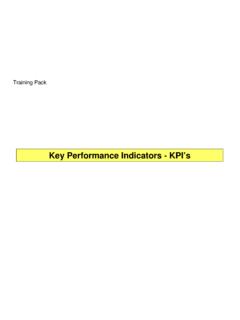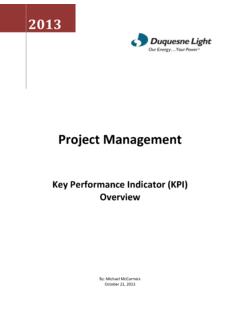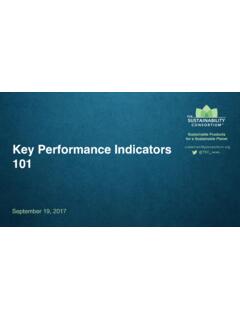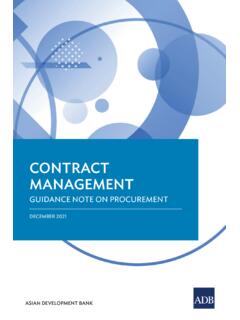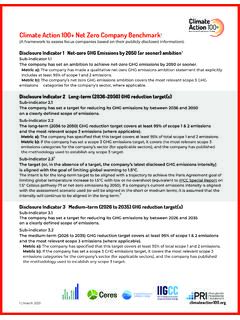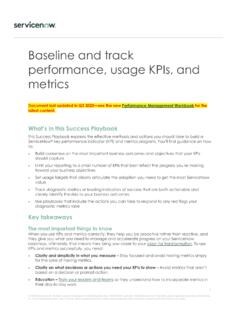Transcription of Key Performance Indicators for Manufacturing
1 Every kind of Manufacturing company, in all industry segments including automotive, food and beverage, health and beauty, electronics, industrial machines, metal fabrication, plastics, etc., rely on measurements to monitor business activities and Performance , document successes and challenges, and help direct management decision-making. Of course, while we measure a number of parameters simply to comply with mandatory accounting and reporting requirements, smart management will incorporate those measurements into valuable intelligence that helps run the business more effectively and more measurements can be used to improve Performance and results in custom Manufacturing and high-volume consumer goods production; in discrete (hard goods) and batch production and in the latest demand-driven hybrid production.
2 Thousands of measurements have been defined over the year including many common measurements that virtually every manufacturer can use things like profit and loss, cash flow, production schedule compliance, inventory turns, and the like. In addition, specific vertical industries have measurements that apply to their situation and can be too much of a good thing, however. Information overload is a real problem when the important gems of intelligence are buried in masses of data. Decision-makers can easily miss the critical early warning while spending entirely too much of their valuable time buried in Performance Indicators for ManufacturingWhitepaper | July 2018 Copyright Acumatica 2018 Page 1 of 9 Among this wide array of possible measurements, each industry has a relatively small number of measures that are particularly important for monitoring the overall health of the business.
3 Commonly called Key Performance Indicators (KPIs), these measurements are often gathered together into an executive dashboard display with graphics that provide an at-a-glance picture to help executives quickly zero in on opportunities or challenges. These dashboards offer drill-down for analysis of the details and can be adapted to provide key measurements to individual departments or functions within the organization, focused on the specific measurements that are important in their individual span of Manufacturing management software, sometimes called back office or ERP (Enterprise Requirements Planning) systems, offer such an Executive Information System with a variety of pre-defined KPIs which the various users within the company can pull together and tweak to fit their specific situation.
4 We are in what might be called a golden age of business intelligence and KPIs. While the proliferation of connected sensors and smart devices, commonly referred to as the Industrial Internet of Things (IIoT), provides unprecedented visibility and control, it also multiplies the Page 2 of 9 Key Performance Indicators for ManufacturingKPIs are a natural on mobile devices to stay on top of the business while in the overload problem. Fortunately, e-technology is also presenting solutions to that problem in the form of powerful yet user-friendly analytics and data visualization tools that are, in effect, extensions or enhancements to the Business Intelligence / Executive Information Systems we ve just discussed.
5 And all of this data, analytics, and business intelligence is made practical and functional by the cloud because only cloud deployment offers the connectivity, integration, security, scalability and capacity necessary to harness all of this data and make the intelligence accessible wherever its needed, whenever its needed. Types of KPIsWhen we think of measurements and KPIs, we are most likely thinking about what can be called historical measurements summaries and analyses of events and data. KPIs compile this data into usable forms that target the specific interest of the viewer, the functional area of the business and the needs of that specific industry and KPIs are financial, as finance is the common language of general business management in Manufacturing and all other industries.
6 Common financial KPIs in every industry monitor sales, costs, margins, cash flow, and asset utilization. But many more KPIs are operational measurements that managers and executives use to focus in on specific activities and interests relative to schedules, inventory, on-time completion, backlog, quality and more. All of these kinds of KPIs can be classified as historical measurements since they focus on analysis of data from activities that have already occurred. Of course we can speculate and try to project how things will play out in the future, and we do that of course, but that is not built into the structure of the measurements.
7 Historical KPIs can be set up with alerts and warnings that monitor and detect exceptions, calling attention to issues through graphic characteristics like traffic lights (green all okay; yellow = an indicator that something is not quite optimum; red = cause for concern) or push alert messages sent via email or KPIs use what can be thought of as leading Indicators to project Performance expectations into the future. Management can use these projections to steer decisions and actions aimed at avoiding undesirable outcomes or enhancing desirable results. Predictive KPIs for the Manufacturing industry may use economic Indicators , demographic trends, or specific industry Indicators like housing starts ( indicator of future demand for plumbing fixtures, windows, carpeting, furniture, etc.)
8 Or health trends (future demand for medications or supplies), for example. Page 3 of 9 Key Performance Indicators for ManufacturingKPIs for the Manufacturing industryAs mentioned above, a number of basic KPIs measure financial Performance and apply to all kind of businesses sales and margin, return on equity, cash flow, and the like. Operational KPIs that are focused on Manufacturing may include common Indicators that everybody already watches like Inventory Turnover Ratio and On-time Delivery as well as others that focus more on specific areas of Manufacturing operations. Plan vs. Actual Hours and CostA prime indicator of how effectively the plant is operating.
9 As plan vs actual data accumulates, trends can be identified to provide early warning of improving or deteriorating Performance . Comparing different areas of the plant, different processes and difference products can offer clues to how to improve overall Page 4 of 9 Key Performance Indicators for ManufacturingUtilization and CapacityLean Manufacturing does not emphasize utilization it is better to have idle equipment than to overproduce or build ahead of the need. That said, there is real value in planning optimum utilization of available resources. Resource load balancing can also generate lower costs and improve on-time completions, reduce overtime and expediting, and improve delivery promise reliability by eliminating uncertainty in planning schedules.
10 The basic Work Center Dispatch KPI, which can be easily customized to better fit your needs, shows workload details for each work center including planned, in-process and optionally completed work so you will always know what each center is working on and what s in queue for Page 5 of 9 Key Performance Indicators for ManufacturingScheduled ProductionAt a more granular level, monitoring production schedules offers better insight into work flow and resource utilization. The Manufacturing Dashboard shown here is the starting point for defining a display of released orders in the plant and the current location and status of each.

